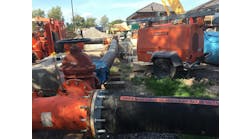Caterpillar Inc. today announced first-quarter 2020 sales and revenues of $10.6 billion, a 21.5-percent decrease compared with $13.5 billion in the first quarter of 2019. The decline was caused by lower sales volume driven by lower end-user demand and the impact from changes in dealer inventories. Dealers increased machine and engine inventories about $100 million during the first quarter of 2020, compared with about $1.3 billion during the first quarter of 2019.
First-quarter 2020 profit per share was $1.98, compared with $3.25 profit per share in the first quarter of 2019. Operating profit margin was 13.2 percent for the first quarter of 2020, compared with 16.4 percent for the first quarter of 2019.
“We remain committed to the safety, health and well-being of our employees around the world, and I am proud of our employees and dealers for their dedication to our customers, their communities and each other,” said Caterpillar chairman and CEO Jim Umpleby. “Our employees deliver products and services that enable our customers to provide critical infrastructure essential to support society during the COVID-19 pandemic.”
Caterpillar has implemented safeguards in its facilities to protect team members, including increased frequency of cleaning and disinfecting facilities, social distancing practices and other measures consistent with specific regulatory requirements and guidance from health authorities.
Many governments classified Caterpillar’s operations as an essential activity for support of critical infrastructure. Caterpillar has suspended operations temporarily at certain facilities during the last several weeks because of supply chain issues, weak customer demand or government regulations. As of mid-April 2020, globally and across the three primary segments, approximately 75 percent of the company’s primary production facilities continue to operate. Some facilities that were temporarily closed have reopened. The company will continue to monitor the situation and may suspend operations temporarily at additional facilities if warranted by business conditions.
The company has taken actions to reduce costs, including reducing discretionary expenses and suspending 2020 base salary increases and short-term incentive compensation plans for many employees and all senior executives. Caterpillar is prioritizing spending to allow continued investment in services and expanded offerings, key elements of its strategy for profitable growth introduced in 2017.
Caterpillar’s financial results for the remainder of 2020 will be impacted by continued global economic uncertainty due to the COVID-19 pandemic. As such, Caterpillar withdrew its earnings guidance on March 26 and is not providing a financial outlook for 2020 at this time.
During the first quarter of 2020, enterprise operating cash flow was $1.130 billion. Caterpillar has taken actions to improve its strong financial position by increasing sources of liquidity. On a consolidated basis, Caterpillar ended the first quarter with $7.1 billion of cash and available global credit facilities of $10.5 billion. In April, Caterpillar raised $2.0 billion of incremental cash by issuing new 10- and 30-year bonds and arranged $8.0 billion of additional back-up facilities to supplement the company’s liquidity position.
“We have taken decisive actions to enhance our strong financial position, while continuing to execute our strategy for profitable growth,” said Umpleby. “Caterpillar has faced and overcome many challenges in our 95-year history. Our goal is to emerge from the pandemic an even stronger company.”
Construction Industries’ total sales were $4.306 billion in the first quarter of 2020, a decrease of $1.567 billion, or 27 percent, compared with $5.873 billion in the first quarter of 2019. The decrease was because of lower sales volume, driven by lower end-user demand and the impact from changes in dealer inventories. Dealers increased inventories significantly more during the first quarter of 2019 than in the first quarter of 2020.
In North America, sales decreased because of lower demand driven by the impact from changes in dealer inventories and lower end-user demand. Dealers increased inventories more during the first quarter of 2019 than in the first quarter of 2020. The lower end-user demand was driven primarily by non-residential and pipeline construction.
Sales declined in Latin America primarily from the impact from changes in dealer inventories and unfavorable currency impacts from a weaker Brazilian real. Dealers decreased inventories more during the first quarter of 2020 than in the first quarter of 2019.
In EAME, the sales decrease was primarily due to lower end-user demand across most of the region and unfavorable currency impacts from a weaker euro.
Sales declined in Asia/Pacific caused by lower end-user demand across most of the region, primarily in China. Decreases in China reflected lower end-user demand mostly due to COVID-19 pandemic-related impacts. Construction Industries’ profit was $640 million in the first quarter of 2020, a decrease of $445 million, or 41 percent, compared with $1.085 billion in the first quarter of 2019. The decrease was mainly due to lower sales volume, partially offset by lower manufacturing costs. Favorable manufacturing costs were primarily the result of lower period manufacturing and material costs, partially offset by higher warranty expense. Lower period manufacturing costs reflected a reduction in short-term incentive compensation expense and targeted cost-reduction actions implemented in response to lower sales volumes.






